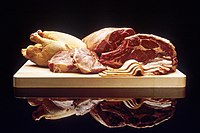
Photo from wikipedia
Pathogenic mycobacteria such as Mycobacterium tuberculosis are capable of utilising cholesterol as a primary carbon-based energy source in vitro but there has been little research examining the significance of cholesterol… Click to show full abstract
Pathogenic mycobacteria such as Mycobacterium tuberculosis are capable of utilising cholesterol as a primary carbon-based energy source in vitro but there has been little research examining the significance of cholesterol in vivo. Johne's disease is a chronic enteric disease of ruminants caused by Mycobacterium avium subspecies paratuberculosis (MAP). This study sought to evaluate the levels of total serum cholesterol in the host following exposure to MAP. Blood samples were collected from both sheep and cattle prior to experimental challenge with MAP and at monthly intervals post-challenge. Total serum cholesterol levels in sheep challenged with MAP were significantly elevated at 9 weeks post-inoculation (wpi) in comparison to controls. When stratified based on disease outcome, there was no significant difference in serum cholesterol at the timepoints examined between MAP exposed sheep that were susceptible and those that were resistant to Johne's disease. There was a similar elevation in serum cholesterol at 9 wpi in cattle with histopathological gut lesions associated with disease or those with an early high IFN-γ response. Total serum cholesterol in exposed cattle was significantly lower when compared to controls at 13 wpi. Taken together, these results demonstrate changes in serum cholesterol following MAP exposure and disease progression which could reflect novel aspects of the pathogenesis and immune response associated with MAP infection in both sheep and cattle.
Journal Title: Veterinary immunology and immunopathology
Year Published: 2018
Link to full text (if available)
Share on Social Media: Sign Up to like & get
recommendations!